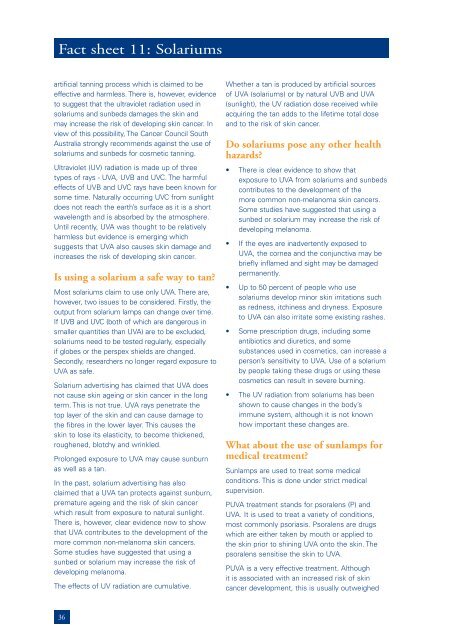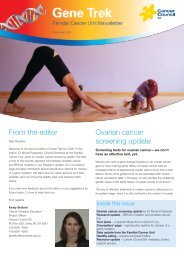Be SunSmart final print file.indd - Cancer Council SA
Be SunSmart final print file.indd - Cancer Council SA
Be SunSmart final print file.indd - Cancer Council SA
You also want an ePaper? Increase the reach of your titles
YUMPU automatically turns print PDFs into web optimized ePapers that Google loves.
Fact sheet 11: Solariums<br />
artificial tanning process which is claimed to be<br />
effective and harmless. There is, however, evidence<br />
to suggest that the ultraviolet radiation used in<br />
solariums and sunbeds damages the skin and<br />
may increase the risk of developing skin cancer. In<br />
view of this possibility, The <strong>Cancer</strong> <strong>Council</strong> South<br />
Australia strongly recommends against the use of<br />
solariums and sunbeds for cosmetic tanning.<br />
Ultraviolet (UV) radiation is made up of three<br />
types of rays - UVA, UVB and UVC. The harmful<br />
effects of UVB and UVC rays have been known for<br />
some time. Naturally occurring UVC from sunlight<br />
does not reach the earth’s surface as it is a short<br />
wavelength and is absorbed by the atmosphere.<br />
Until recently, UVA was thought to be relatively<br />
harmless but evidence is emerging which<br />
suggests that UVA also causes skin damage and<br />
increases the risk of developing skin cancer.<br />
Is using a solarium a safe way to tan?<br />
Most solariums claim to use only UVA. There are,<br />
however, two issues to be considered. Firstly, the<br />
output from solarium lamps can change over time.<br />
If UVB and UVC (both of which are dangerous in<br />
smaller quantities than UVA) are to be excluded,<br />
solariums need to be tested regularly, especially<br />
if globes or the perspex shields are changed.<br />
Secondly, researchers no longer regard exposure to<br />
UVA as safe.<br />
Solarium advertising has claimed that UVA does<br />
not cause skin ageing or skin cancer in the long<br />
term. This is not true. UVA rays penetrate the<br />
top layer of the skin and can cause damage to<br />
the fibres in the lower layer. This causes the<br />
skin to lose its elasticity, to become thickened,<br />
roughened, blotchy and wrinkled.<br />
Prolonged exposure to UVA may cause sunburn<br />
as well as a tan.<br />
In the past, solarium advertising has also<br />
claimed that a UVA tan protects against sunburn,<br />
premature ageing and the risk of skin cancer<br />
which result from exposure to natural sunlight.<br />
There is, however, clear evidence now to show<br />
that UVA contributes to the development of the<br />
more common non-melanoma skin cancers.<br />
Some studies have suggested that using a<br />
sunbed or solarium may increase the risk of<br />
developing melanoma.<br />
The effects of UV radiation are cumulative.<br />
36<br />
Whether a tan is produced by artificial sources<br />
of UVA (solariums) or by natural UVB and UVA<br />
(sunlight), the UV radiation dose received while<br />
acquiring the tan adds to the lifetime total dose<br />
and to the risk of skin cancer.<br />
Do solariums pose any other health<br />
hazards?<br />
•<br />
•<br />
•<br />
•<br />
•<br />
There is clear evidence to show that<br />
exposure to UVA from solariums and sunbeds<br />
contributes to the development of the<br />
more common non-melanoma skin cancers.<br />
Some studies have suggested that using a<br />
sunbed or solarium may increase the risk of<br />
developing melanoma.<br />
If the eyes are inadvertently exposed to<br />
UVA, the cornea and the conjunctiva may be<br />
briefly inflamed and sight may be damaged<br />
permanently.<br />
Up to 50 percent of people who use<br />
solariums develop minor skin irritations such<br />
as redness, itchiness and dryness. Exposure<br />
to UVA can also irritate some existing rashes.<br />
Some prescription drugs, including some<br />
antibiotics and diuretics, and some<br />
substances used in cosmetics, can increase a<br />
person’s sensitivity to UVA. Use of a solarium<br />
by people taking these drugs or using these<br />
cosmetics can result in severe burning.<br />
The UV radiation from solariums has been<br />
shown to cause changes in the body’s<br />
immune system, although it is not known<br />
how important these changes are.<br />
What about the use of sunlamps for<br />
medical treatment?<br />
Sunlamps are used to treat some medical<br />
conditions. This is done under strict medical<br />
supervision.<br />
PUVA treatment stands for psoralens (P) and<br />
UVA. It is used to treat a variety of conditions,<br />
most commonly psoriasis. Psoralens are drugs<br />
which are either taken by mouth or applied to<br />
the skin prior to shining UVA onto the skin. The<br />
psoralens sensitise the skin to UVA.<br />
PUVA is a very effective treatment. Although<br />
it is associated with an increased risk of skin<br />
cancer development, this is usually outweighed



